We are developing the social individualist meta-context for the future. From the very serious to the extremely frivolous... lets see what is on the mind of the Samizdata people.
Samizdata, derived from Samizdat /n. - a system of clandestine publication of banned literature in the USSR [Russ.,= self-publishing house]
|
Hannah Thoburn has an interesting article on World Affairs called Putin the Unifier:
There’s nothing like an invasion to bring a country together. Ask any Ukrainian on any street and they’ll tell you the same thing, almost thankfully: Vladimir Putin has united Ukraine like never before. His actions in eastern Ukraine have proven a kind of catalyst that have forged a nation out of a group of people that once squabbled incessantly about politics, language rights, and tax dollars.
Southern Ukrainians who once sighed in exasperation at the “nationalists from the west” of Ukraine (as the common saying went) are now excited about the election to Parliament of a new, youthful, pro-European party, Self-Reliance, which hails from that region. Perhaps, one woman told me, they can teach us how to begin to “live in the European way.” Some in customarily Russian-speaking areas have taken to purposefully speaking Ukrainian so as to not perpetuate Russian soft power.
This pretty much squares with what I have heard from people I know or correspond with in the Ukraine. They tend to be deeply cynical about domestic corruption and local politicians generally, but all have told me hostility to the Kremlin and pro-western sentiments now largely transcends narrower political groupings, making for some eye widening collaboration amongst very unlikely allies. A guy I know also said much the same thing about many Russians becoming very vocally Ukrainian, with some going ‘deep nationalist’ as only Russians can these days, just not in the way the charming Mr. Putin might have expected.
Does anyone have noticed that when a Kremlin supporter talks about Eastern Europe the first thing he/she does is to erase the Eastern Europe countries from discussion, presenting the case as US/EU vs Russia?
This is a typical debate framing.
For [the Kremlin apologists] of this world Ukraine, Poland, the Lithuania, Estonia, Latvia don’t have any right to an opinion. Erased with it is a history of occupation under Soviets. For them only Russia has a right to be paranoid. The others once occupied by them for 50 years don’t.
– Samizdata commenter LuckLucky
I am giving a talk at a Libertarian Home meeting at the Rose and Crown pub in Southwark this Thursday evening the 2nd of October. (All welcome. Please come). The initial motivation for this talk was to attempt to shed some light on the causes of the current war in Ukraine. When I thought about is some more, I realised that while the Ukrainian situation is interesting (in an extraordinarily depressing way) the subject is more interesting in the broader context of Russian relations with the countries of the former USSR in general.
As it happens, I have spent a lot of time travelling in the countries of the former USSR. In the last year I have been to Russia, Belarus, Ukraine, Moldova, Georgia, Armenia, and Lithuania, as well as the two most significant countries that are now in NATO and the EU, but which were formerly communist and Warsaw pact (Poland and Romania). With the exception of Belarus and Russia itself, these countries were not new to me – I have visited all of the others multiple times in the last five years, as well as every other formerly communist country in Europe. I have also visited the breakaway / Russian occupied territories of Transnistria in Moldova and Abkhazia in Georgia. I have seen a lot, and learned a lot, and this helps greatly in trying to understand what is going on. (To my great regret, I do not speak Russian. I would no doubt have learned a lot more if I did).
I have been told to talk for 20 to 30 minutes. I have chosen a gigantic subject for this length. I only have time to give a quick impression of each country, I fear, and a brief attempt to tie things together. For these impressions to make any sense at all, some historical and cultural background is necessary. Therefore, I am writing this article as a brief primer, and hopefully something that people will find interesting in its own right. People who wish to add things, disagree with things, tell me I am completely wrong etc in the comments are most welcome. I a not going to talk about communism at all. I am going to talk about everything in terms of ethnic nationalism and territorial changes.
→ Continue reading: A plug for a talk, and some background
Now there is a sight I will never get tired of seeing. Better late than never!
Vladimir Putin has warned the Ukrainian government against getting closer to the EU, threatening their access to Russian markets.
So the Ukraine has to decide between losing their access to 142 million Russians with a total GDP of $2.1 trillion (official), or improving their access to 511 million people with a total GDP of $16.95 trillion (official).
Hmm, yes I can see how that might be a difficult decision 😀
Okay, but there are ways of going about that which do not involve asking Russian tanks to cross the border in support and shooting down passenger jets. Last I looked, Scotland wasn’t fighting English soldiers in the streets, parading captured Englishmen through the streets of Aberdeen, and handing out weapons to Glasgow Celtic fans willy-nilly. I’d not have any problem if East Ukraine had attempted peaceful means of seceding from Kiev, but they haven’t: it’s been thuggish violence from the outset.
– Tim Newman, commenting here on Samizdata.
The evidence that confirms what anyone paying attention suspected has been released: Russian artillery is firing on Ukrainian forces across the border from inside Russia. And the PutinBots in the comment sections of the world’s media are out in force saying “nothing to see here, move along”.
The only surprising thing about this is that anyone is surprised. World War 3 is not at hand, but it is definitely time to pay more attention and point more guns eastward.

Minsk, Belarus. May 2014
Ah yes. Marc O’Polo, the great Irish explorer who travelled to and returned from the O’Rient.
And whilst attention is focused on the horror in the Middle East…does that later day Mussolini (Russian edition) and gay icon Vladimir Putin invade the Ukraine?
Probably. The real question being, where is the Stop Line?
Crowdfunding military procurement? Could this be the best idea ever? Or at least the best idea since letters of marque?
Actual link to the project here.
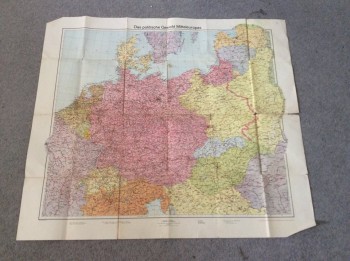
Partly due to despair at my unwillingness to decorate my flat in any way whatsoever, and partly because she knows I like this kind of thing, a friend of mine sent me this antique map of central Europe as a gift. She obtained it in an antiquarian map shop in Krakow, Poland.
First, obvious observation. This is a map from Nazi Germany. In the margin, it is identified as being the product of a mapmaker in Leipzig, but there is no date given.
Secondly, when I see a historical map, I like to play the game of figuring out the dates of the map by looking at the border, and using my historical knowledge of political geography to narrow the date down.
Figuring out the year of this map is easy. This map is from 1939. In most instances, getting the year is all you want to do. However, 1939 was a somewhat problematic year.
Klaipeda and the area around it is shown as part of Germany, not Lithuania. Also, Czechoslovakia has ceased to exist, Bohemia and Moravia has been annexed by the Reich, Slovakia is a supposedly independent country, and Carpathian Ruthenia has been invaded and annexed by Hungary. All these events occurred in March 1939, so the map was clearly designed after March 1939.
It’s looking at Poland that things get interesting. Firstly, Danzig is not shown as a free city, but is shown as part of the Reich. Danzig was invaded by Germany on 1 September 1939, proclaimed part of Germany on 2 September, and formally annexed under German law on 8 October. Danzig had, however, been under the control of the local Nazi party since 1933, and would have joined Germany instantly if it had been allowed to under international law. Is it possible that some German maps showed Danzig as part of Germany prior to September 1939? Possible, but I suspect probably not.
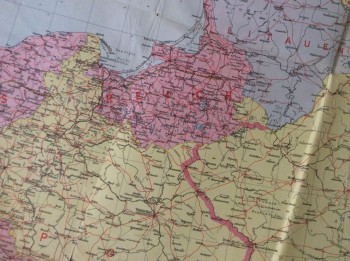
By far the most fascinating thing in this map is the red line through Poland, however. Poland is clearly identified as “Polen”, but the Molotov-Rippentrop line – it the limits of German occupation after the invasion of Germany in September 1939 – has been drawn through it. Therefore the map must have been printed no earlier than September 1939. This has clearly been printed at the same time as the rest of the map – it is not something someone added with a pen later, or anything like that.
What I suppose is possible is that the mapmaker had a map prepared reflecting recent border changes immediately prior to the German invasion of Poland in September 1939. When the invasion occurred, the map was quickly modified to show Danzig as German and the zones of German and Soviet occupation before being printed and sold.
And yet, this map does not reflect the view of the world that the Nazis wanted to present. Upon invading Poland, they declared that Poland as a country did not exist. On that same date of October 8, Germany formally annexed the northern and western sections of their Polish conquests (including the Suwalki triangle, clearly shown on this map), and declared the South-East to be the “General-government”, essentially a German colony (but not a “Germany colony in Poland”, as Poland did not exist). This map is therefore curious, as it essentially shows Poland (clearly identified as Poland) under German (and Soviet) occupation.
I cannot imagine maps like this being printed in Germany long after the annexation decree of October 1939. In the Nazi view, there was no occupied Poland the way there was later an occupied France. There was simply German territory that unfortunately happened to have Poles, other Slavs, and Jews living in it. It’s easy to imagine foreign maps from later showing the German and Soviet occupation of Poland like this, but German ones, not so much. So my conclusion is that this map was printed very soon indeed after the German invasion of Poland in September 1939.
Plus of course this map ended up in an antiquarian map shop in Krakow in Poland, which between 1939 and 1945 was in that aforementioned “General Government”. One has no idea how and when it got there, but I suspect that “during the occupation” is the most likely answer.
Thoughts anyone?
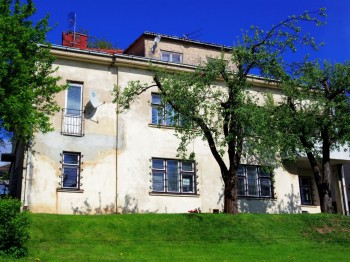
I visited the above house in Kaunas, Lithuania last month. In 1940, this house was the Japanese consulate. Kaunas functioned as the capital city of Lithuania prior to the Second World War. The Lithuanians considered Vilnius to be their rightful capital, but it was masquerading as the Polish city of Wilno at the time. Upon the German occupation of Western Poland and the Soviet occupation of Eastern Poland in late 1939, many (both Polish and Lithuanian) Jews were trapped in Lithuania and clearly in great danger, but were unable to gain exit visas to leave the Soviet Union (or travel across it by the Trans-Siberian railway) unless they had visas to go somewhere else. There were Japanese government rules stating that transit visas could be issued to Japan, but only if the applicant had plans to go somewhere else after Japan, and also that he had adequate financial resources.
Seeing the desperation of the situation, and against orders, Japanese consul Chiune Sugihara issued Japanese transit visas to anyone who asked. (In the book Bloodlands historian Timothy Snyder – who clearly finds Sugihara as fascinating a figure as I do – makes it clear that Sugihara was a Japanese spy as well as a Japanese consul, and his job was to keep track of Soviet troop movements for the Japanese government). During September 1940 he spent something like 20 hours a day writing out visas. When the consulate was closed and he had to leave, he was followed by a crowd to the railway station. As his train left, he was still throwing blank visas with his seal and signature on them to a crowd of desperate people. In total, he wrote something like 3000 visas, and as dependent family members could travel on the same visa as the principal person it was written for, those visas covered several times that number of people.
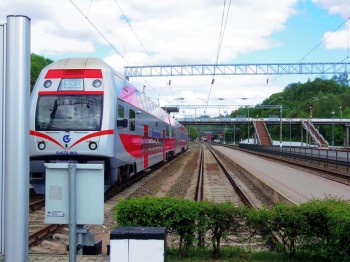 Kaunas railway station today. Kaunas railway station today.
Upon receiving these visas, Jews were able to travel on the Trans-Siberian railway to Vladivostok and then go by ship to Japan. They then dispersed to various places, but many were deported to Shanghai when the tripartite pact with Germany was signed shortly afterwards. Shanghai was also under Japanese occupation, and there these people spent time in the Shanghai ghetto – Restricted Sector for Stateless Refugees – where they stayed until Shanghai was liberated by the Americans in 1945. I visited the remnants of the Shanghai ghetto in 2006, and wrote about it at the time. Although this was crowded and at times squalid, it was a place of relative safety. The Japanese behaved monstrously towards certain other groups, but they had nothing against Jews, and did not turn the Jews in Shanghai over to the Germans despite German requests. Rather cleverly, Jewish leaders in Shanghai played upon Japanese mistrust of their German allies. Upon being asked by a Japanese governor why the Germans hated the Jews so much, rabbi Shimon Sholom Kalish replied “They hate us because we are short and dark haired”.
Most Jews who got to Shanghai survived, and then emigrated to Israel, Australia, the US and other places after 1945. Estimates of the number of lives saved by Sugihara go as high as 10,000, although estimates of about 6,000 seem more common.
Half of the building in Kaunas is now a museum to Sugihara. I wanted to see this – it was why I went to Kaunas. The other people in the museum when I went there were a busload of Japanese tourists. Almost everyone who had signed the guest book had done so in Japanese, too. I didn’t see any Lithuanians or many other Europeans, which is a shame given this extraordinary story.
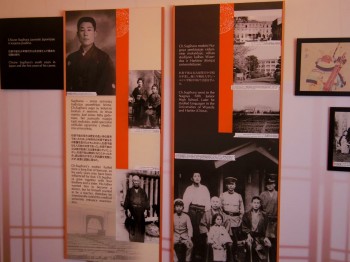
It’s an exceptionally good thing that the museum is there, but I did find the tone of the museum to be slightly curious. The museum did seem to be going out of its way to present the Japanese in general in the best possible light overall, rather than simply telling the story of Sugihara. That Sugihara was acting against orders was mentioned but not emphasised, and much was made of Jews who reached Japan being treated well, but not much was said about where they went after the Japanese alliance with Germany intensified and they were deported from Japan. The truth – the Shanghai ghetto mentioned above – doesn’t actually reflect too badly on the Japanese, but it is rather unfortunately connected to other things that do reflect badly on the Japanese. It is impossible to praise Sugihara himself too much – the man saved the lives of 6,000 or more people just out of basic human decency – but does this reflect well on Japan as a whole? That is harder to say. As is the case with other various people who did similar things, his story remained obscure for many years. His career with the Japanese foreign service ended after the war for reasons that may or may not have had to do with disobeying orders in Lithuania.
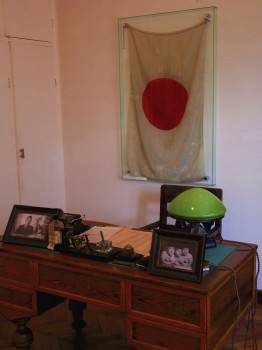
Eventually, Sugihara’s story became widely known, and he was later honoured by Yad Vashem, the state of Israel, the state of Japan and the state of Lithuania, but this took a long time. As it did with Paul Grüninger, Oskar Schindler, and others.
|
Who Are We? The Samizdata people are a bunch of sinister and heavily armed globalist illuminati who seek to infect the entire world with the values of personal liberty and several property. Amongst our many crimes is a sense of humour and the intermittent use of British spelling.
We are also a varied group made up of social individualists, classical liberals, whigs, libertarians, extropians, futurists, ‘Porcupines’, Karl Popper fetishists, recovering neo-conservatives, crazed Ayn Rand worshipers, over-caffeinated Virginia Postrel devotees, witty Frédéric Bastiat wannabes, cypherpunks, minarchists, kritarchists and wild-eyed anarcho-capitalists from Britain, North America, Australia and Europe.
|










